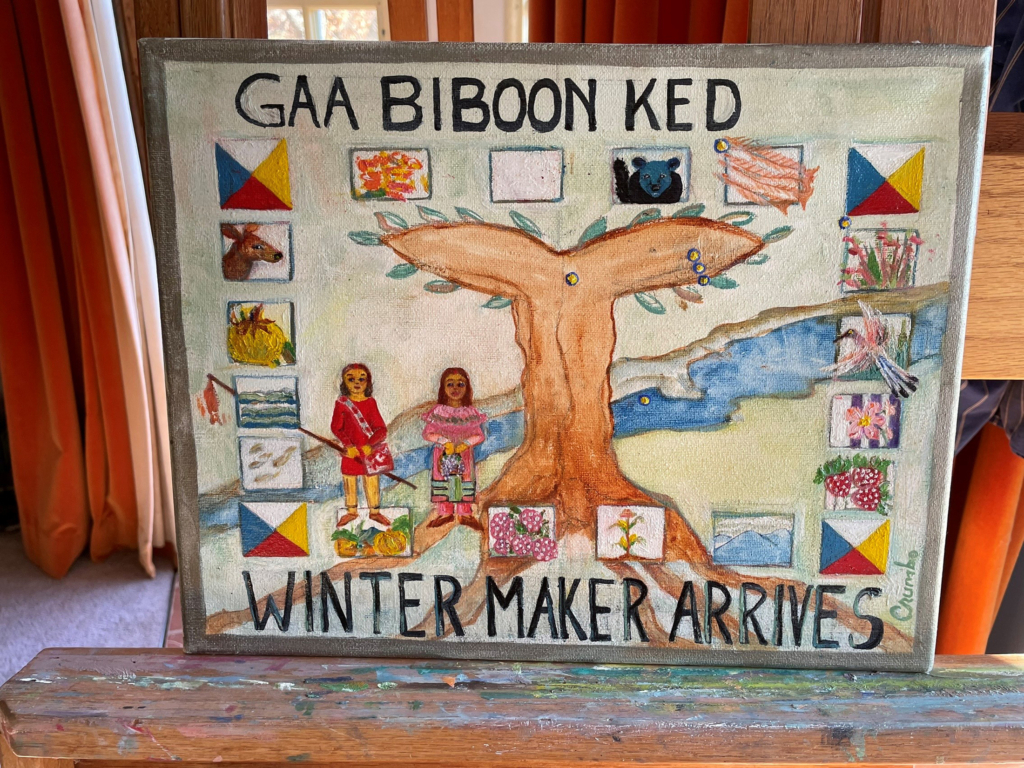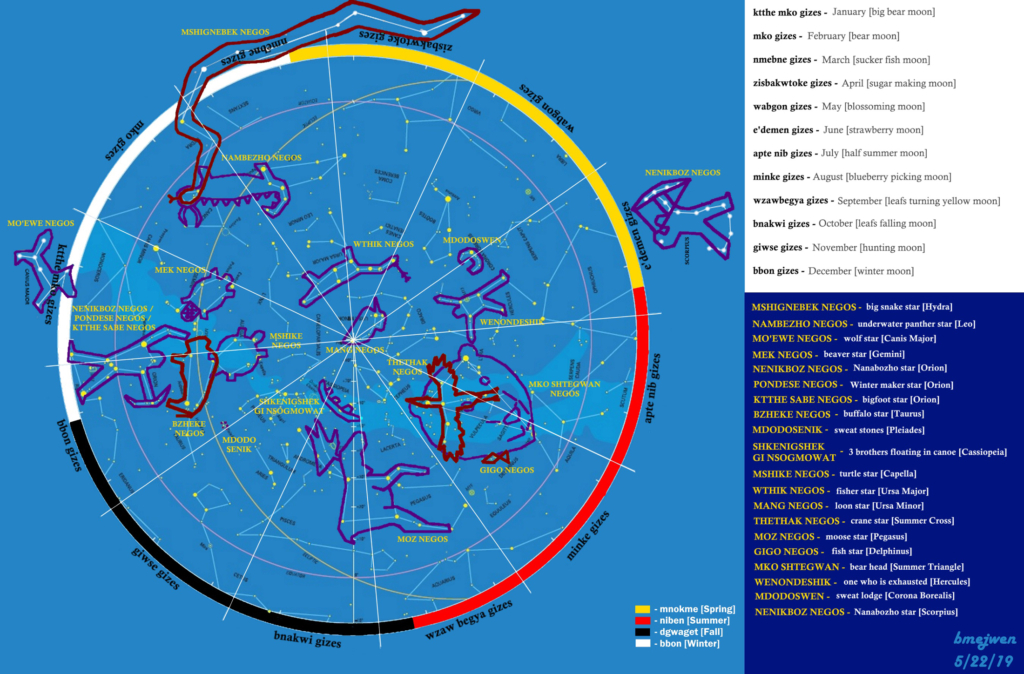Potawatomi artist Minisa Crumbo Halsey leaned into her creative side by painting and writing during the 2020 pandemic and lockdown. One of her paintings explores traditional star knowledge. It is a subject she shared with the community during an April 3, 2024, presentation at the Citizen Potawatomi Nation Cultural Heritage Center.
Pondésé Nëgos, or Winter Maker, focuses on the constellation known as Orion’s Belt. Pondésé Nëgos is most visible in the night sky during winter in the northern hemisphere, from January to April. The painting features a boy and girl in traditional clothing, standing by the Canadian River under the Tree of Life.

The constellation was named Orion’s Belt in the second century by astronomer Ptolemy, but its origins are even older to the Potawatomi. Unlike constellations named for Greek myths, Potawatomi constellations describe seasonal activities, such as the time when wild rice is harvested or the approach of spring.
As an artist, Crumbo Halsey hopes the painting will encourage Potawatomi to embrace the traditional star knowledge Nishnabé people have relied upon for hundreds of years.
Crumbo Halsey said as a child she observed the stars while her father pointed out the locations of the morning star, the evening star, the North Star and more.
“These are the first things that he began pointing out that I knew had importance, enough for him to point out and give me a teaching on,” she said. “That (taught me) I could follow my inner spirit of willingness and enthusiasm to learn and be connected with the mother earth and the father sky, sun and the Creator, which is the first, most beautiful and enduring gifts that the Creator gave us.”
Stars and origin stories
Stars represent the origins of the Potawatomi people.
“When we talk about the stars, we’re talking about origin,” Crumbo Halsey said. “We are people that are lowered down from the stars. The Seven Sisters, the stones that were lowered down from the sky people and the star people became the teachings for the stones that go into the sweat lodge ceremony. That’s one of the things that makes it so powerful is that they represent us and our star ascent or descent.”

Star stories may also answer questions about the afterlife.
“One of the reasons that we get a (Potawatomi) name, aside from it being our true identity that we live and work and grow in, is that when we walk on, the ancestors know how to call. They know what our name is, and they can call us on home. And we begin that journey to return to the stars,” she said.
“The star beings include not only where we came from, but the very, very deep and profoundly beautiful medicine of traditional teachings. Like, ‘Where do we go when we walk on?’ Well, we have a teaching on that.”
Crumbo Halsey said Indigenous societies all over the world have lived in regard to the stars, to know when to plant, when to harvest, when to prepare for seasonal changes and more. Constellation stories are tied to the Potawatomi way of life and relationships to nature.
“There are specific stars that will appear in the spring. One of them is the crane constellation that appears specifically between spring and fall,” she said. “The crane guides the geese going north, and they fly right under that constellation. And in the fall, when they migrate south, you can look up and they’ll be under the constellation of the crane.”

The story of the sucker fish moon represents an important sacrifice.
“Up in the north country, sucker fish appeared in March. They have a moon named after them because at the end of the winter season, the game was scarce, and people were hungry. A fisherman went out and cut a hole in the ice. The sucker fish spoke and said some of us are going to sacrifice ourselves for you, because we know that you’re hungry. They allowed some of them to be caught and they lived. We always remember the sacrifice,” Crumbo Halsey said.
Stars also hold importance when it comes to the Seven Grandfather Teachings.
“The Seven Grandfather Teachings are love, respect, bravery, honesty, wisdom, truth and humility. It is from these things, the star story and these Seven Grandfather teachings, that we come to know more about ourselves and define ourselves and our connection and relationship to all living things in a good way.”

Resources
Crumbo Halsey said there are several books available that offer more information. She recommends the works of the late Jim Thunder, a well-known Forest County Potawatomi elder, Nishinawbe Aski First Nation author Joseph Ogimaawab Sutherland and more. Many titles are available on Amazon or through tribal retailers.
“Amazon has several titles that deal with star stories and ‘creation myths.’ I don’t like the word ‘myth’ because it indicates there are questions about the validity of the story. I prefer ‘creation stories,’ but it will be under ‘myths’ on Amazon,” she said.
Combined with a smartphone app called Star Guide, Crumbo Halsey said the knowledge can be shared all year long.
“With Sky Guide, you can take the cell phone up in the night sky and point it to any star in the night sky, and the message will come up about what constellation we’re looking at,” she said.
She recommends using the Star Guide app in conjunction with the Star Chart created by Kyle Malott of the Pokagon Band Potawatomi. Malott’s chart features traditional Anishnabé constellations and their names. Access the Star Chart online at cpn.news/starchart.

Reclaiming knowledge
Crumbo Halsey is eager to share what she has learned with the Potawatomi community. During the year, she will share her knowledge through a series of articles in the Hownikan.
She has an optimistic view of reclaiming traditional knowledge.
“Some of us have shame that we weren’t raised traditionally and don’t know these things. We feel like we can’t access it, or we won’t be able to understand it, or someone’s going to laugh at us, or we’re going to fail in our endeavor. But, if we go with the seven grandfather teachings, we are armed with a shield. We are armed with a shield of truth,” she said.
For more information about her art and books, visit Crumbo Halsey’s website.

